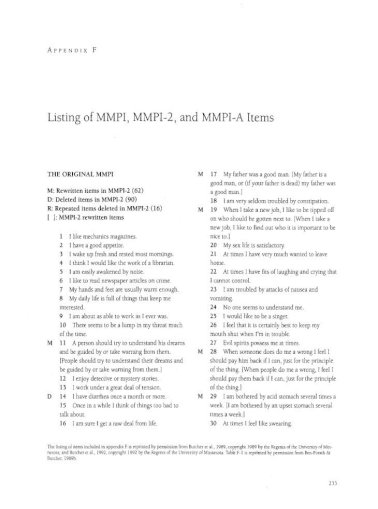

Personally, I've noticed in my very limited experience that the higher a person scores on a K-corrected scale, the more necessary and accurate said alteration becomes and the reason for this is simple: the more a personality uses these traits involved in the K validity scale, the more likely they are to attempt hiding them, which is why the K-correction validity scale exists to begin with. This embarrassing tidbit (one that applies to all dimensions explicitly marked below as K-corrected) is still a subject of debate, but the fact that Pearson is charging extra for a result more basic than the one it always includes ought to provide a hint as to which side of the debate is likely to persevere ultimately. Scale 1 gets a K-correction applied to it during computation, with only the most exceedingly expensive versions of the test giving the evaluator both a K-corrected and a non-K corrected score, the reason being that peer-reviewed articles have accumulated that conclude that more often than not the non- K corrected scores are more accurate. It is precisely this preocupation that the Hs scale intends to measure. Most people feel excessive preocupation, anxiety, or multiple low-intensity fears in their bellies, as a queazy feeling or unnerving nausea. The gut, in fact, carries out a large amount of our emotional processes, containing the vast majority of our serotonin neurotransmitters, which play a big role in mood regulation. Though hypochondriasis is nowadays synonymous with a constant psychosomatic generation of physical illness, the term hypochondriasis comes from the Ancient Greek "ὑποχόνδριος" (hypokhondrios), which denotes "the soft parts between the ribs and navel".

The following are succinct descriptions of what each scale attempts to approximate: The main Clinical Scales of the Minnesota Multiphasic Personality Inventory are almost always referred to via the numbers assigned to each (i.e., the numbers provided below to the right of the abbreviated lettering that appears on the free, online version linked to on this site). What appears on the report a test-taker keeps. Infrequency, and K correction, similar to Se discuten las implicaciones para la práctica forense de los resultados.MMPI-2 Scoring Chart with Clinical Scales, Lie,

Además, los resultados evidenciaron validez incrementada de F-r sobre Fp-r y viceversa. En la clasificación de casos, las escalas F-r, Fp-r, FBS-r, Fs y RBS clasificaban correcta y significativamente entre simuladores y respuestas honestas de la población general, y las escalas F-r and Fp-r entre simuladores y población clínica. Los resultados mostraron que los simuladores puntuaban significativamente más alto que los sujetos de las poblaciones general y clínica en las escalas F-r, Fp-r, FBS-r, Fs y RBS. Participaron en el estudio 878 sujetos, 309 de la población general, 308 casos clínicos y 261 instruidos para simular daño psicológico. Se utilizó un diseño de investigación de simulación para evaluar la eficacia de las escalas de validez de evaluación de la simulación en la discriminación entre simuladores y las poblaciones general y clínica en el contexto forense. Forensic practical implications from the results were derived and discussed.Īunque el MMPI-2 ha sido el instrumento psicométrico más usado en la evaluación forense, está siendo reemplazado gradualmente por la versión reestructurada, el MMPI-2-RF precisándose de más evidencia científica para ello. Thus, F-r and Fp-r scales are independent and may be accumulated to detect malingering. Additionally, the results showed F-r incremental validity over Fp-r, and vice versa. As for the classification of cases, the F-r, Fp-r, FBS-r, Fs, and RBS scales classified correctly and significantly between malingerers and honest respondents from the general population, and the F-r and Fp-r scales between malingerers and clinical population. The results showed that malingerers scored significantly higher than the clinical and general population on the F-r, Fp-r, FBS-r, Fs and RBS scales. Of a total of 878 subjects, 309 were from the general population, 308 from the clinical population, and 261 were instructed to malinger a psychological injury. A malingering design was implemented to assess the efficacy of the overreporting validity scales in discriminating between a group of malingerers and the general and clinical populations in a forensic context. Though it has been the most extensively used instrument for forensic evaluation, the MMPI-2 is being gradually replaced by the MMPI-2-RF version, requiring evidence research to support it.


 0 kommentar(er)
0 kommentar(er)
